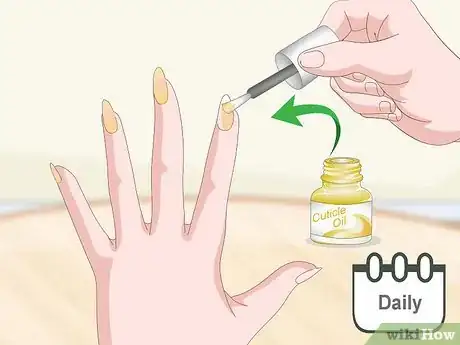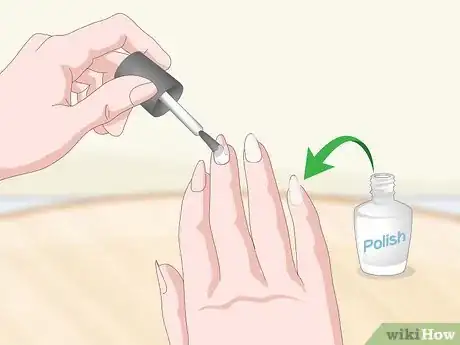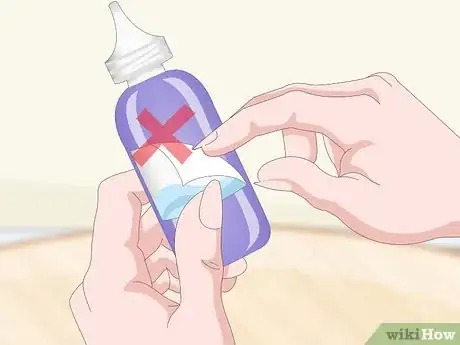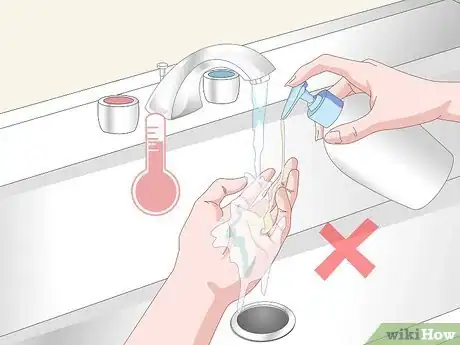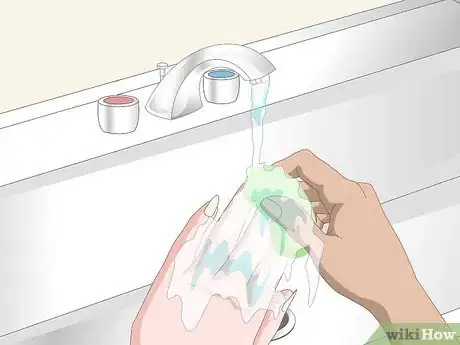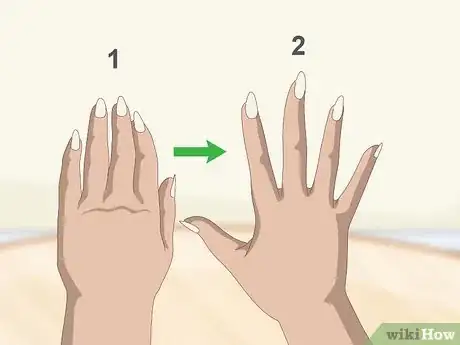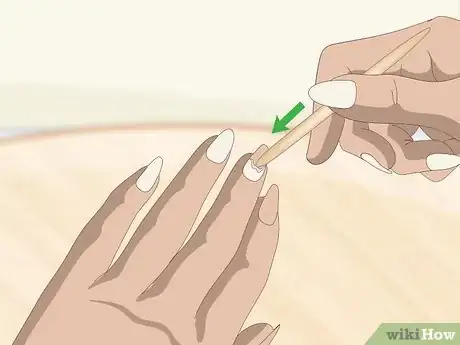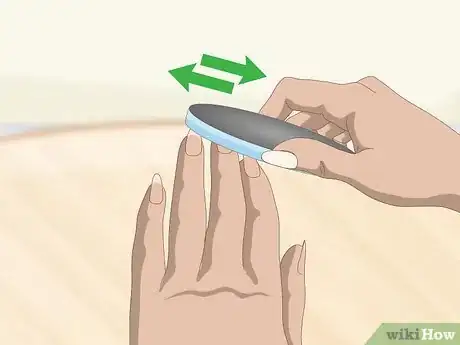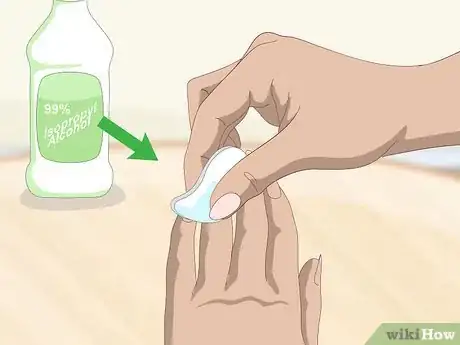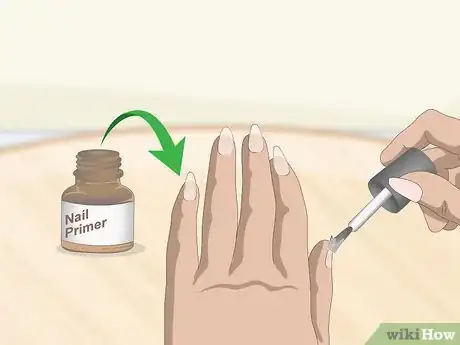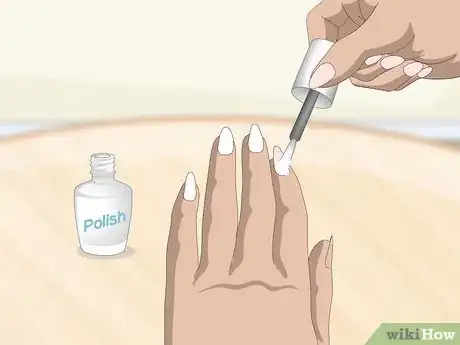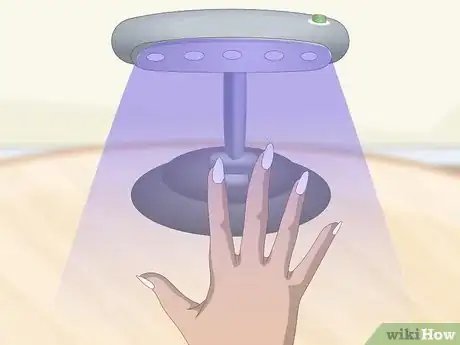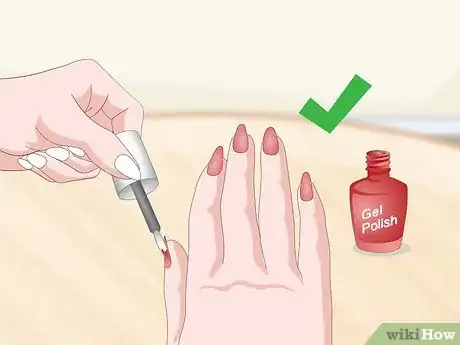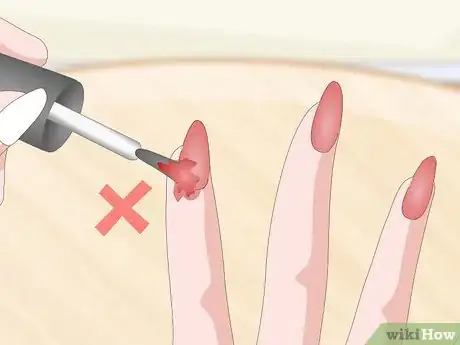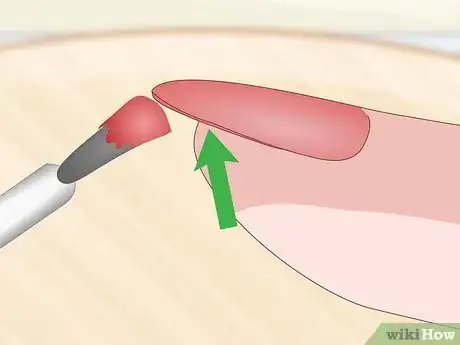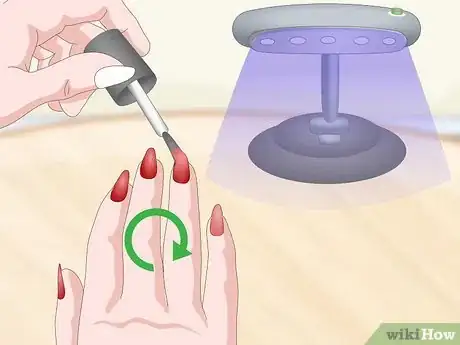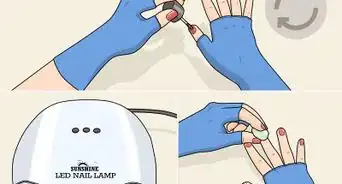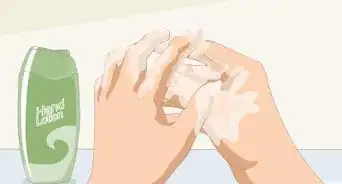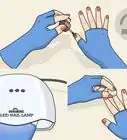This article was co-authored by Kristin Pulaski. Kristin Pulaski is a Professional Nail Artist and the Founder of Paintbucket, a self-owned and operated nail salon based in Williamsburg, Brooklyn. She has over five years of experience running Paintbucket and is licensed as a nail technician. Paintbucket offers nail art manicures, pedicures, and soft gel extensions along with customized packages for wedding and bridal parties. She holds a BA in Managerial Science from Manhattan College.
There are 12 references cited in this article, which can be found at the bottom of the page.
This article has been viewed 120,421 times.
Gel nail polish is a great option to obtain a shiny, durable manicure or pedicure. If you just got gel nails done at the salon, there are things you can do at home to make the polish last as long as possible, such as conditioning your nails, adding clear polish, and protecting your nails from hot water. If you’re doing your own manicure, take a few steps both before you begin and while applying the gel polish to preserve your polish. If you follow these steps, you can enjoy a gel manicure that lasts up to 2 weeks or longer!
Steps
Preserving Your Gel Nails After Application
-
1Use cuticle oil daily to condition your nails. Prepping your nails and cuticles before applying the gel polish makes them very dry, so you’ll need to put the moisture back in them once your manicure is complete. Dry nails will become flaky, causing the polish to come off prematurely. To keep your nails moisturized apply cuticle oil every day by brushing it on your cuticles and your skin around it.[1]
- For extra softness and conditioning, apply the cuticle oil right before bed and follow up with moisturizing hand lotion.
-
2Add a thin layer of clear polish over your nails after one week. A great way to prevent chipping gel polish is to reapply a topcoat about a week after the gel manicure. You can use a gel topcoat and cure it with the light. Or, you can use regular clear nail polish and let it air dry. To seal the tips of your nails, run the brush along the top edge first before covering the entire nail with the top coat.[2]
- Continue to reapply a top coat every few days to minimize your manicure or pedicure from chipping.
Advertisement -
3Be gentle with your nails. When you have a fresh new gel manicure, be mindful of everything you're doing with your hands and fingers. Even the slightest chip on the edge of the nail can get bigger and lift from the nail bed. So avoid doing things that can damage the edge of the polish, such as tearing open packages or scraping sticky labels off of surfaces.[3]
-
4Avoid using hot water or cleaning products. If you want your gel manicure to last at least 2 weeks without chipping or lifting, try your best to avoid prolonged exposure to hot water. This means if you plan on washing the dishes or cleaning, wear gloves to protect your nails. Hot water and chemicals from cleaning products can seep into the polish and cause it to breakdown, resulting in chipping and peeling. [4]
Prepping Your Nails for a Lasting Result
-
1Don't use hot water or soap on your nails before your gel manicure. Some people like to wash or soak their nails before starting a manicure or pedicure. This is not a good idea, because soap contains oils that can adhere to the nail. This can cause lifting of the gel polish after application. You want your nails to be completely dry, so avoid moisture at all costs before painting them.[5]
- Stay away from tasks that expose your nails to water for at least an hour before gel application, such as washing the dishes or taking a shower. This is because your nails retain water for a while.
-
2Prep and prime each hand separately for best results. Focusing on 1 hand at a time helps you do an even, accurate job preparing each nail. Start with the hand that's easiest for you, then move on to the hand that feels harder. Go slowly so you'll make fewer mistakes. This will set you up for the best manicure possible.
- Don't rush your prepping and priming process or you'll undermine the purpose.
-
3Push back your cuticles to clear your nail bed. Applying nail polish over your cuticles can cause the polish to lift and chip after drying. The first thing you should do before polishing your nails is to use a wooden cuticle stick to push your cuticles as far back on each fingernail as possible. If you have a significant amount of cuticles, gently use the stick to scrape them off the nail.[6]
- Use a wooden cuticle pusher instead of a metal one, because wooden ones are soft and won’t harm the nail bed.
- You can also use a cuticle remover to soften your cuticles before pushing or removing. However, make sure it is oil-free.
-
4Buff your nails with a nail buffer. The purpose of buffing is to smooth out the surface of the nail bed and remove any excess dry skin. To do this, hold the buffer parallel to your nail, and buff your entire nail by rubbing quickly back and forth from edge to edge. Try to use no more than 6 strokes per nail, or you may over buff them.
- Use the side of your nail buffer with the coarsest texture. Usually, this side will be colored black.
- Make sure you use a buffer on your nail bed and not a file. A file is very rough, and should only be used for the edge of the nail.
- You can find a nail buffer at most beauty supply stores. Sometimes they are shaped like a rectangular block, while others may be shaped like a Popsicle stick.
-
5Cleanse your nails with 99% isopropyl alcohol and a lint-free wipe. It is important to make sure that your nails are completely dry and free of debris before applying gel polish. Cleanse by applying 99% isopropyl alcohol to each nail. Pour a small amount on a cotton pad and rub it on each nail. You will see your nails start to slowly appear chalky and very dry. Then, wipe each nail with a lint-free wipe.[7]
-
6Use nail primer if you want to dehydrate the nail even further. A nail primer will help to dry out the nail bed and assist with the adhesion of the gel polish. It can be purchased at any beauty supply store. Just apply a thin even coat with the brush provided, and allow it to dry. Application of this product will prevent lifting and chipping, especially when applied to the tips of your nails.[8]
- You can dehydrate your nail bed even more by applying pure acetone with a cotton pad. Make sure to avoid the cuticles when applying acetone; you don’t want to dry them out too much.[9]
-
7Apply a thin layer of base coat to your nails. Before starting your gel manicure, apply a gel base coat to each nail. This is a critical step, as the base coat allows the gel polish to completely adhere to the nail. Use the brush that comes with the base coat to paint the entire nail, without touching the cuticle or nail bed. Make sure you also paint the tip of the nail to prevent chipping.[10]
- It’s important to avoid getting the base coat on the cuticle or nail bed. If it does, the polish may lift, and the manicure will not last long.
-
8Dry the base coat under an LED or UV lamp. Immediately after applying the base coat, put your nails under an LED or UV lamp to cure it. If you have an LED lamp, cure the base coat for at least 30 seconds. If you have a UV lamp, leave your nails under for 1 minute.[11]
- Follow the manufacturer’s instructions to determine whether the gel polish cures or dries best with LED or UV light. It varies depending on the type of gel polish you purchase.
Applying the Gel Polish Properly
-
1Paint thin layers of gel polish on your nails. When putting on nail polish, make sure you apply thin layers. To do this, dip the brush in the nail polish, then wipe a little bit off the side of the container before touching the brush to the nail. If you apply thick layers with too much polish, they might not completely dry and that will cause smudging.[12]
- Apply at least 2 thin layers of polish, but no more than 3.
-
2Work quickly, focusing on 1 hand at a time for precision. The gel polish will set more evenly if you apply it quickly. Brush the polish on as fast as you can without being sloppy, then go immediately to the next nail. Finish all of the nails on 1 hand before you turn your attention to your other hand, which will help you keep your results as neat as possible.
- You don't need to rush, but you also don't want to take your time. Don't pause between nails, spend a lot of time dipping your brush, or stop to examine your work after each nail.
-
3Avoid getting gel polish on your cuticles and skin. It is important to avoid getting any gel polish on your cuticles or skin while you’re painting your nails. Even a small drop of polish on your skin can cause it to separate from the area after it dries because this prevents the nail from being fully sealed. This is because gel polish does not adhere to the skin.[13]
- If you accidentally get the gel polish on your skin or cuticle during application, quickly remove it with a wooden cuticle stick or cotton swab before curing it.
-
4Cap the gel polish on the tip of the nail for each layer you apply. When applying gel polish, make sure to cap the edges of the nail. To do this, paint the entire nail, and then paint over it a little bit underneath the edge of the nail. This will help to delay chipping because the polish will wrap around the nail and cling to it. When it does start to chip, you won’t notice it because it will chip on the edges first before coming off the tip of the nail.[14]
- When capping the edge, make sure the coat is as thin as possible to avoid peeling.
-
5Cure each coat completely before adding the next coat. The most important part of the gel manicure is arguably using either UV or LED lights to cure the polish. The lighting is used to dry and harden the gel polish, making it last longer than a regular manicure. Leave your nails under the light for the recommended amount of time right after you apply a coat. Gel nails under LED lights take about 30 seconds to cure on average, while UV lamps take 1-2 minutes to cure.[15]
- Keep in mind that UV bulbs need to be changed on a regular basis. If not, the light will dim, resulting in dull gel colors and faster chipping. LED bulbs do not need to be changed.
- UV lamps should be at least 36 watts, while LED lamps need to be 18 watts for most gel polish brands to fully cure. [16]
-
6Add a top coat and cure it under the lamp. Once you finish applying a few coats of your gel polish, finish off your manicure with a topcoat. This is an important step to seal the gel, and it adds an extra layer of protection. As with the base coat and gel coats, avoid getting the top coat on your skin and cuticles. Cure it under the UV or LED light when you’re finished applying.[17]
Expert Q&A
Did you know you can get expert answers for this article?
Unlock expert answers by supporting wikiHow
-
QuestionHow do I stop my gel nails from peeling?
 Kristin PulaskiKristin Pulaski is a Professional Nail Artist and the Founder of Paintbucket, a self-owned and operated nail salon based in Williamsburg, Brooklyn. She has over five years of experience running Paintbucket and is licensed as a nail technician. Paintbucket offers nail art manicures, pedicures, and soft gel extensions along with customized packages for wedding and bridal parties. She holds a BA in Managerial Science from Manhattan College.
Kristin PulaskiKristin Pulaski is a Professional Nail Artist and the Founder of Paintbucket, a self-owned and operated nail salon based in Williamsburg, Brooklyn. She has over five years of experience running Paintbucket and is licensed as a nail technician. Paintbucket offers nail art manicures, pedicures, and soft gel extensions along with customized packages for wedding and bridal parties. She holds a BA in Managerial Science from Manhattan College.
Salon Owner & Nail Specialist Gel nails peel because something in the application process went wrong. In order to apply correctly, you need the nail to be as dry as possible. Before painting your nails, rub them with a cotton ball dipped in alcohol to remove any moisture. Then, apply a base coat and let it dry completely before applying the gel.
Gel nails peel because something in the application process went wrong. In order to apply correctly, you need the nail to be as dry as possible. Before painting your nails, rub them with a cotton ball dipped in alcohol to remove any moisture. Then, apply a base coat and let it dry completely before applying the gel. -
QuestionHow do I remove gel polish from my nails?
 SylghoulsTop AnswererBuff the surface of your nails with a nail file to remove the shine, then soak a cotton ball in an acetone solution and place it directly on top of your nail. Follow by wrapping each finger with a small piece of foil, and after 10 to 15 minutes, the gel manicure should slide right off with the cotton ball.
SylghoulsTop AnswererBuff the surface of your nails with a nail file to remove the shine, then soak a cotton ball in an acetone solution and place it directly on top of your nail. Follow by wrapping each finger with a small piece of foil, and after 10 to 15 minutes, the gel manicure should slide right off with the cotton ball. -
QuestionHow do I get rid of fingernail fungus?
 SylghoulsTop AnswererCheck out the techniques in this article. If those tricks don't work, see a doctor about it.
SylghoulsTop AnswererCheck out the techniques in this article. If those tricks don't work, see a doctor about it.
Things You’ll Need
- Cuticle stick (wood)
- Nail buffer
- 99% isopropyl alcohol
- Lint-free wipes
- Nail primer
- 100% acetone (optional)
- Base coat
- LED or UV Lamp
- Gel polish
- Topcoat
- Cuticle oil
References
- ↑ https://www.thesun.co.uk/living/3690197/make-your-gel-manicure-last-for-a-whole-month/
- ↑ https://stylecaster.com/beauty/gel-manicure/
- ↑ https://www.purewow.com/beauty/how-to-make-your-gel-manicure-last
- ↑ https://www.purewow.com/beauty/how-to-make-your-gel-manicure-last
- ↑ Kristin Pulaski. Salon Owner & Nail Specialist. Expert Interview. 19 May 2020.
- ↑ https://youtu.be/Jmxl9guXllc?t=52
- ↑ Kristin Pulaski. Salon Owner & Nail Specialist. Expert Interview. 19 May 2020.
- ↑ Kristin Pulaski. Salon Owner & Nail Specialist. Expert Interview. 19 May 2020.
- ↑ https://sonailicious.com/dos-donts-gel-nails-at-home/
- ↑ Kristin Pulaski. Salon Owner & Nail Specialist. Expert Interview. 19 May 2020.
- ↑ Kristin Pulaski. Salon Owner & Nail Specialist. Expert Interview. 19 May 2020.
- ↑ https://youtu.be/G7VMYL4VXHs?t=417
- ↑ https://youtu.be/G7VMYL4VXHs?t=593
- ↑ https://www.youtube.com/watch?v=G7VMYL4VXHs
- ↑ https://www.allure.com/story/gel-manicure-led-uv-light
- ↑ https://youtu.be/G7VMYL4VXHs?t=517
- ↑ https://youtu.be/hQTkfd-p9LI?t=58
